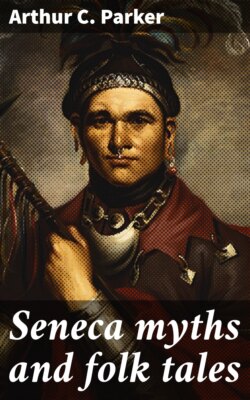Читать книгу Seneca myths and folk tales - Arthur C. Parker - Страница 5
На сайте Литреса книга снята с продажи.
INTRODUCTION
ОглавлениеTable of Contents
In presenting this collection of Seneca myths and legends, the collator feels that he should explain to the general reader that he does not offer a series of tales that can be judged by present day literary standards. These Indian stories are not published for the mere entertainment of general readers, though there is much that is entertaining in them, neither are they designed as children’s fables, or for supplementary reading in schools, though it is true that some of the material may be suited for the child mind. It must be understood that if readings from this book are to be made for children, a wise selection must be made.
This collection is presented as an exposition of the unwritten literature of the Seneca Indians who still live in their ancestral domain in western New York. It is primarily a collection of folk-lore and is to be looked at in no other light. The professional anthropologist and historian will not need to be reminded of this. He will study these tales for their ethnological significance, and use them in making comparisons with similar collections from other tribes and stocks. In this manner he will determine the similarities or differences in theme, in episode and character. He will trace myth diffusion thereby and be able to chart the elements of the Seneca story.
There is an amazing lack of authentic material on Iroquois folk-lore, though much that arrogates this name to itself has been written. The writers, however, have in general so glossed the native themes with poetic and literary interpretations that the material has shrunken in value and can scarcely be considered without many reservations.
We do not pretend to have made a complete collection of all available material, but we have given a fairly representative series of myths, legends, fiction and traditions. One may examine this collection and find representative types of nearly every class of Seneca folk-lore. Multiplication is scarcely necessary.
The value of this collection is not a literary one but a scientific one. It reveals the type of tale that held the interest and attention of the Seneca; it reveals certain mental traits and tendencies; it reveals many customs and incidents in native life, and finally, it serves as an index of native psychology.
The enlightened mind will not be arrogant in its judgment of this material, but will see in it the attempts of a race still in mental childhood to give play to imagination and to explain by symbols what it otherwise could not express.
While there is much value in this collection explaining indirectly the folk-ways and the folk-thought of the Seneca and their allied kinsmen, the whole life of the people may not be judged from these legends. Much more must be presented before such a judgment is formed. Just as we gain some knowledge of present day religions, governmental methods, social organization and political economy from the general literature of the day, but only a portion, and this unsystematized, so do we catch only a glimpse of the life story of the Seneca from their folk-tales.
To complete our knowledge we must have before us works on Seneca history, ethnology, archæology, religion, government and language. Finally, we must personally know the descendents of the mighty Seneca nation of old. We must enter into the life of the people in a sympathetic way, for only then can we get at the soul of the race.
While all this is true, these folk-tales are not to be despised, for they conserve many references to themes and things that otherwise would be forgotten. Folk-lore is one of the most important mines of information that the ethnologist and historian may tap. We can never understand a race until we understand what it is thinking about, and we can never know this until we know its literature, written or unwritten. The folk-tale therefore has a special value and significance, if honestly recorded.
